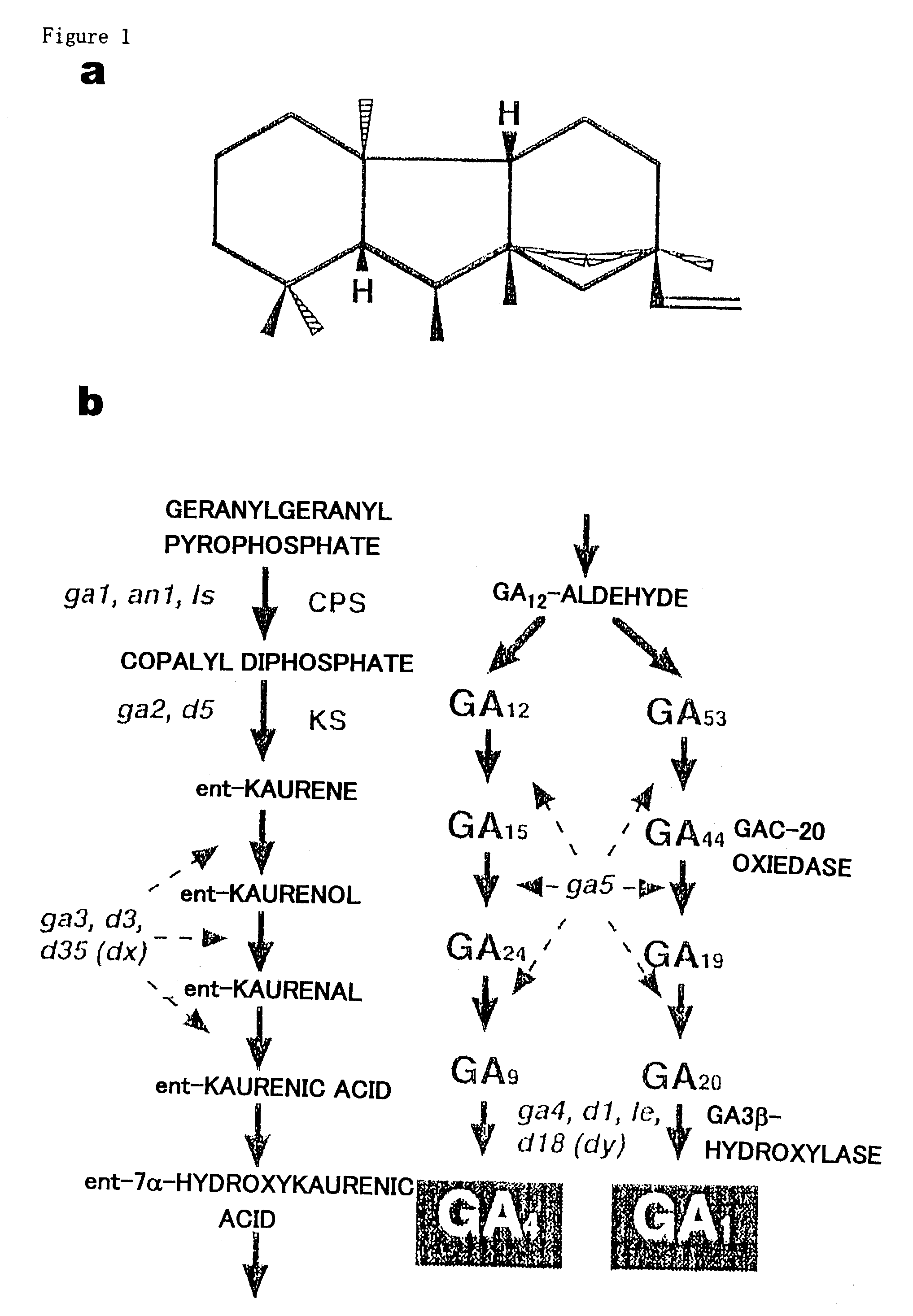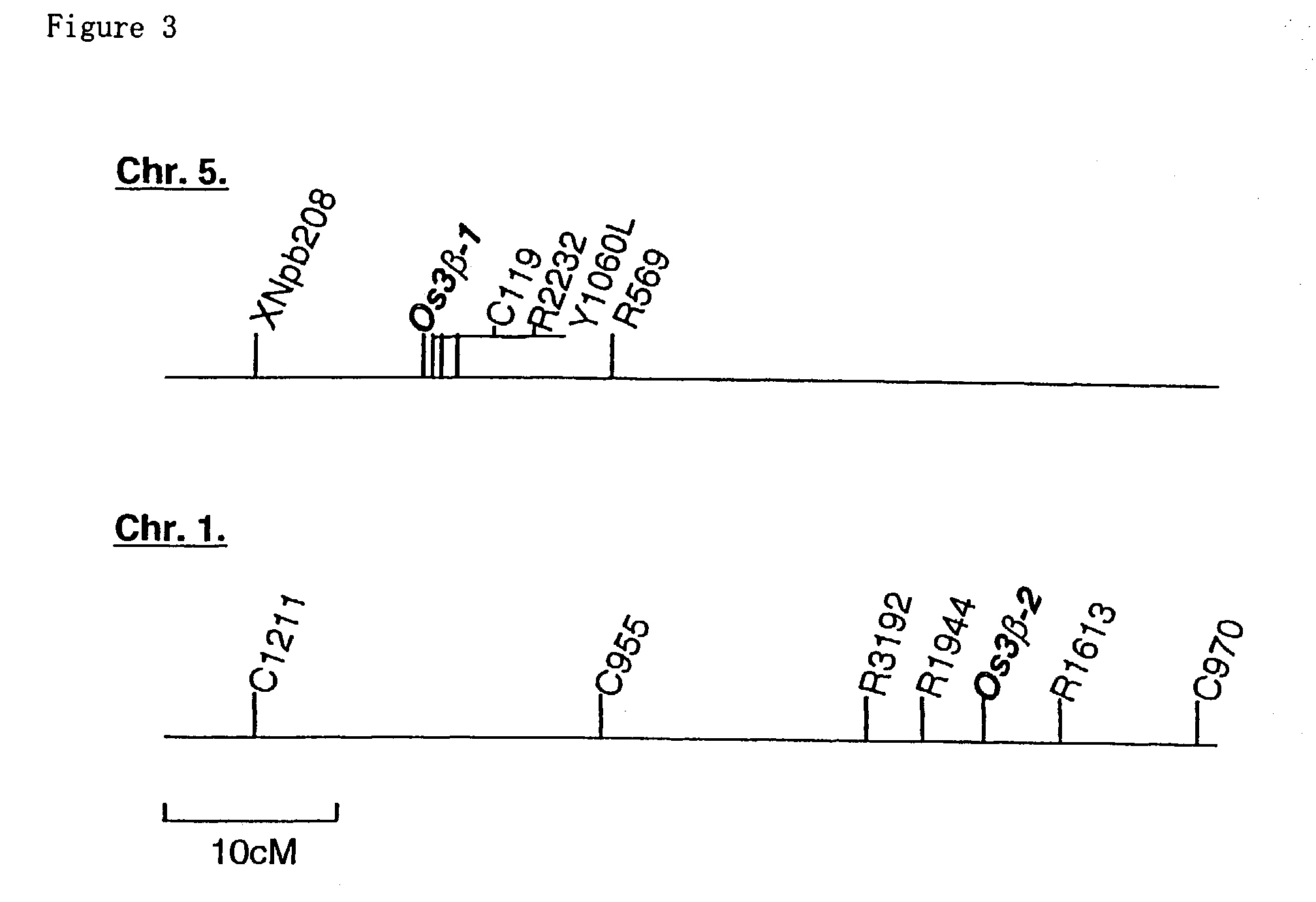Gibberellin 3β-hydroxylase genes of rice and uses thereof
a technology of gibberellin and hydroxylase, which is applied in the field of rice genes, can solve the problems of inability to determine the exact amount of each ga in a specific tissue, the site of synthesis of bioactive gas and their mode of action in specific cells and tissues, and the lack of supporting evidence. , to achieve the effect of reducing the number of fruits, reducing the number of gibberellin 3hydroxylase genes, and reducing the number of g
- Summary
- Abstract
- Description
- Claims
- Application Information
AI Technical Summary
Benefits of technology
Problems solved by technology
Method used
Image
Examples
example 1
Isolation of cDNA Clone Encoding GA 3β-hydroxylase
[0079]No report on isolation of GA 3β-hydroxylase in monocots is available. Several GA 3β-hydroxylases have been cloned from dicots (Chiang et al., 1995; Martin et al., 1997; Lester et al., 1997).
[0080]For the isolation of a partial fragment encoding GA 3β-hydroxylase, PCR was performed using the rice genomic DNA as a template and degenerate primers (5′ primer: 5′-GTNGTNAARGTNGGNGARRT-3′ / SEQ ID NO: 7; 3′ primer: 5′-AYYTARTCRTTGGANGTNAC-3′ / SEQ ID NO: 8) designed from the conserved region among the reported dicot's GA 3β-hydroxylase sequences. A 210-bp DNA fragment, which corresponds to the size expected from the reported GA 3β-hydroxylase sequences, was obtained.
[0081]To isolate full-length clones, the present inventors screened the rice genomic library with this fragment as a probe. Several clones were isolated and were divided into two groups based on the restriction map of each genomic clone. Finally one clone of each group was ent...
example 2
Identification and Characterization of d18 Alleles
[0084]Previous quantitative analyses and bioassay of the dwarf rice plants indicated that the D18 gene encodes a GA 3β-hydroxylase. The D18 locus has been identified on chromosome 1, flanking to the FS-2 locus at the bottom of this chromosome. To investigate that the isolated GA 3β-hydroxylase clones correspond to the D18 gene, the present inventors mapped two clones on the rice genome using RFLP (Restriction Fragment Length Polymorphism) analysis.
[0085]RFLP of Os3β-1 or Os3β-2 were present between Asominori (a Japonica rice) and IR 24 (an Indica rice) DNAs digested with EcoRI or ApaI, respectively. Linkage analysis was performed with digested genomic DNA from F2 progeny of crosses between Asominori and IR 24. Os3β-1 and Os3β-2 are mapped on the top of chromosome 5 and the bottom of chromosome 1, respectively (FIG. 3). This result suggests that the Os3β-2 locus corresponds to the D18 locus.
[0086]Further analysis was performed to conf...
example 3
Regulation of the Os3β-2 (D18) and Os3β-1 Genes During Plant Growth
[0094]To investigate the expression of the D18 and Os3β-1 genes during plant growth, RNA gel blot analysis was performed. For this analysis, total RNA was prepared from various organs or tissues by the standard method (Sambrook et al., 1989). RNA (10 μg per sample) was separated by gel electrophoresis and transferred to a Hybond N+ nylon membrane (Amersham). Hybridization was performed at 65° C. in a solution containing 5×SSC, 10% (w / v) dextran sulfate, 0.5% (w / v) SDS, 0.1 mg / ml denatured salmon sperm DNA. Filters were washed twice for 15 min at 65° C. in 2×SSC, 0.1% SDS and once in 0.1×SSC, 0.1% SDS at 65° C. for 15 min. A BssHII-PvuII (519 bp) fragment from full-length D18 cDNA and a KpnI-PvuII (310 bp) fragment from Osβ-1, were used as probes.
[0095]D18 gene was expressed in every organ tested (FIG. 5). The levels of expression were high in stems, young leaves, and inflorescence meristems, and low in leaf blades an...
PUM
 Login to View More
Login to View More Abstract
Description
Claims
Application Information
 Login to View More
Login to View More - R&D
- Intellectual Property
- Life Sciences
- Materials
- Tech Scout
- Unparalleled Data Quality
- Higher Quality Content
- 60% Fewer Hallucinations
Browse by: Latest US Patents, China's latest patents, Technical Efficacy Thesaurus, Application Domain, Technology Topic, Popular Technical Reports.
© 2025 PatSnap. All rights reserved.Legal|Privacy policy|Modern Slavery Act Transparency Statement|Sitemap|About US| Contact US: help@patsnap.com



